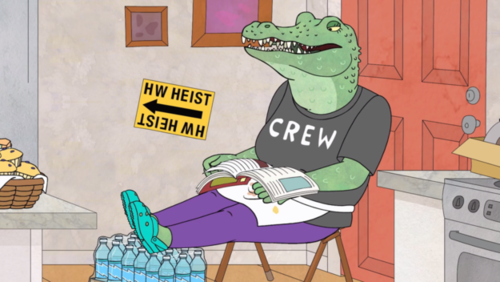Hello! I am going to answer your question, and then I am going to talk a little bit about GENDER IN COMEDY, because this is my tumblr and I can talk about whatever I want!
The vast vast vast majority of the animal jokes on BoJack Horseman (specifically the visual gags) come from our brilliant supervising director Mike Hollingsworth (stufffedanimals on tumblr) and his team. Occasionally, we’ll write a joke like that into the script but I can promise you that your top ten favorite animal gags of the season came from the art and animation side of the show, not the writers room. Usually it happens more the second way you described— to take a couple examples from season 2, “Okay, we need to fill this hospital waiting room, what kind of animals would be in here?” or “Okay, we need some extras for this studio backlot, what would they be wearing?”
I don’t know for sure, but I would guess that the croc wearing crocs came from our head designer lisahanawalt. Lisa is in charge of all the character designs, so most of the clothing you see on the show comes straight from her brain. (One of the many things I love about working with Lisa is that T-Shirts With Dumb Things Written On Them sits squarely in the center of our Venn diagram of interests.)
NOW, it struck me that you referred to the craft services crocodile as a “he” in your question. The character, voiced by kulap Vilaysack, is a woman.
It’s possible that that was just a typo on your part, but I’m going to assume that it wasn’t because it helps me pivot into something I’ve been thinking about a lot over the last year, which is the tendency for comedy writers, and audiences, and writers, and audiences (because it’s a cycle) to view comedy characters as inherently male, unless there is something specifically female about them. (I would guess this is mostly a problem for male comedy writers and audiences, but not exclusively.)
Here’s an example from my own life: In one of the episodes from the first season (I think it’s 109), our storyboard artists drew a gag where a big droopy dog is standing on a street corner next to a businessman and the wind from a passing car blows the dog’s tongue and slobber onto the man’s face. When Lisa designed the characters she made both the dog and the businessperson women.
My first gut reaction to the designs was, “This feels weird.” I said to Lisa, “I feel like these characters should be guys.” She said, “Why?” I thought about it for a little bit, realized I didn’t have a good reason, and went back to her and said, “You’re right, let’s make them ladies.”
I am embarrassed to admit this conversation has happened between Lisa and me multiple times, about multiple characters.
The thinking comes from a place that the cleanest version of a joke has as few pieces as possible. For the dog joke, you have the thing where the tongue slobbers all over the businessperson, but if you also have a thing where both of them ladies, then that’s an additional thing and it muddies up the joke. The audience will think, “Why are those characters female? Is that part of the joke?” The underlying assumption there is that the default mode for any character is male, so to make the characters female is an additional detail on top of that. In case I’m not being a hundred percent clear, this thinking is stupid and wrong and self-perpetuating unless you actively work against it, and I’m proud to say I mostly don’t think this way anymore. Sometimes I still do, because this kind of stuff is baked into us by years of consuming media, but usually I’m able (with some help) to take a step back and not think this way, and one of the things I love about working with Lisa is she challenges these instincts in me.
I feel like I can confidently say that this isn’t just a me problem though— this kind of thing is everywhere. The LEGO Movie was my favorite movie of 2014, but it strikes me that the main character was male, because I feel like in our current culture, he HAD to be. The whole point of Emmett is that he’s the most boring average person in the world. It’s impossible to imagine a female character playing that role, because according to our pop culture, if she’s female she’s already SOMEthing, because she’s not male. The baseline is male. The average person is male.
You can see this all over but it’s weirdly prevalent in children’s entertainment. Why are almost all of the muppets dudes, except for Miss Piggy, who’s a parody of femininity? Why do all of the Despicable Me minions, genderless blobs, have boy names? I love the story (which I read on Wikipedia) that when the director of The Brave Little Toaster cast a woman to play the toaster, one of the guys on the crew was so mad he stormed out of the room. Because he thought the toaster was a man. A TOASTER. The character is a toaster.
I try to think about that when writing new characters— is there anything inherently gendered about what this character is doing? Or is it a toaster?
“This thinking it’s stupid and wrong and self perpetuating unless you actively work against it.” There it is again, the realization of how such biases lurk in our subconscious, in our muscle memory, and getting rid of it is an active, conscious effort. You can’t “just write” because only actively thinking about this stuff stops these biases from happening, and they must be stopped.
Might have reblogged this before, but it always warrants reblogging.
very interesting details.

Just another WordPress site
